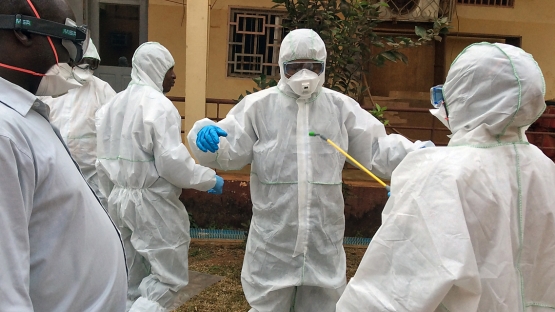From the outside, it looks like an ordinary 50x50x50 cm box, but inside that box is an emergency toolkit, packed with an array of critical laboratory testing materials to support African veterinary laboratories in the rapid detection of highly pathogenic avian influenza viruses. Of course, it is one thing to support veterinary laboratories with a toolkit, it’s quite another to decide what that toolkit should contain. Created by the Joint FAO/IAEA Division of Nuclear Techniques in Food and Agriculture, it called for a lot of pre-testing and prior knowledge of the laboratory environments in recipient countries, in order to ensure it would contain everything a lab would need to perform proper diagnosis of avian influenza. The take-up of the instant diagnostic package in kit format was so positive that the Joint Division expanded its support by also providing companion biosecurity cases containing all of the personal protective equipment, sampling materials and disinfectants needed for field gathering and secure shipment of samples for testing in veterinary laboratories.
The increasing incidence of transboundary animal and zoonotic disease outbreaks, with emergence and re- emergence of new animal diseases, can often be traced to changes in climate, changes in agricultural practices and increasing global trade. When a new animal disease emerges, laboratories are often caught without the capacity for rapid diagnosis, making its control a real challenge.
That is what the emergency toolkits developed by the Joint Division are all about. Developed for diagnosis of avian influenza, they now sit at the ready in laboratories across West Africa, while others have been prepared and remain on standby, ready to be shipped immediately from the Joint Division laboratory in Seibersdorf, Austria, when and where needed.
While a complete toolkit is certainly an ideal approach for an effective response to an emerging disease, setting up such a kit requires that its contents cover the necessary lab procedures, travel and store well, and work with whatever lab equipment and machines the target labs are working with. There can be no margin for error when the emergency toolkit is needed. The Joint Division therefore did extensive pre-testing and also asked laboratories to conduct tests at their ends of some of the toolkits contents. Through this concerted effort, they determined that, for example, some reagents included for some specific tests were not as delicate as feared and would work well without the need to maintain a cold chain during shipping and storage.
To increase its effectiveness in emergency situations, the toolkit has been developed in a way that it can be used for several different diseases with just minor and simple modifications. However, when it comes to diseases such as Ebola, it becomes more challenging because of the potential biosafety aspect of samples containing the Ebola virus.



